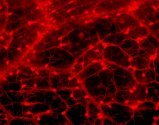
COBRE
Department of Ophthalmology
University of Oklahoma Health Sciences Center
HOME | PI | PJIs | CORES | MENTORS | IAC | EAC | SPOTLIGHT | SEMINARS | CALENDAR | AFFILIATES
Molecular Biology
Image Acquisition and Production
Animal Core
Lipid Analysis
MOLECULAR BIOLOGY CORE FACILITY
Robert E. Anderson has appointed Raju V.S. Rajala as the new module director for the Molecular Biology Core in December 2011. Ms. Fatemeh Shariati, the lab technician, is working under the guidance of Raju Rajala in this Core Module.
The Molecular Biology Module in its present form has been in operation since 2009. The module is supported by the Vision COBRE grant and supports the research programs of COBRE funded projects primarily through DNA purification from tissues and PCR-based genotyping. The module also supports investigators through maintenance of equipment used for gene expression analysis by real-time PCR and immuno blots. All equipment has functioned normally during this period.
Real-time PCR analysis: This module supports four real-time PCR machines that are strategically located in the Molecular Biology Module and in laboratories of NE-funded investigators. Access is granted 24 hours per day, 7 days per week.
Immuno Blot Analysis: The module supports three Kodak Image Station 4000 instruments. These instruments are equipped with sensitive 16-bit high resolution digital cameras that are capable of detecting chemiluminescence signals. Two of the machines are located in the Ophthalmology department basement and 4th floor lab areas (Pavilion B), while the third instrument is located in the Cell Biology department. The module also supports a BioRad FX molecular imager which can be used for fluorescent-labeled immuno blots. Oversight of each instrument is assigned to individuals at each site and access is granted 24 hours per day, 7 days per week.
High-throughput Molecular Analysis: This module supports three BMG labtech FLUOstar OPTIMA microplate readers. Two are located on the 4th floor of the DMEI building and the other is located in the Department of Cell Biology. These instruments can be used for multiple types of analysis using fluorescence, luminance, and absorption. They are equipped with temperature controls and dual reagent injectors. Types of analyses that can be performed include FRET, time-resolved fluorescence, luminescence detection in luciferase and dual luciferase assays, calcium measurements, cell toxicity, cell proliferation, cell viability, ELISA and quantification of proteins and nucleic acids.
Spectrophotometer with Rapid Kinetics Accessory: This module supports a Schimadzu VU-2550 Spectrophotometer which is located on the 4th floor of the new DMEI building. This instrument can be used to study substrate binding and isomerization, rapid enzyme kinetics, formation of intermediates, trapping of transient free radicals, generation and effect of second messengers and ligand-protein interactions. In addition, the instrument will serve the purpose of a common spectrophotometer, which is routinely required to estimate nucleic acids, protein, and normal enzyme reactions, and their binding as well as thermal denaturations and activations. The software provided with this system will help find the Km, Vmax, Kcat and other enzyme reaction parameters with ease.
PCR-based genotyping: This is by far the most important function of the molecular biology module. There is a tremendous need for this service on campus. More than 75% of the genetically modified mice used on the OUHSC campus are maintained and used by Vision Center investigators. All PJIs use genetically modified mice, and therefore could have use of this module. Investigators ear tag mice and collect 2 mm ear punch samples or 3 mm tail-snip samples. DNA is prepared for PCR using proteinase-K digested tissues. When necessary, DNA is purified by phenol-chloroform extraction. This DNA can be used for genotyping by PCR or Southern blots. To PCR genotype mice or tissue samples, prepared DNA will be used as templates in PCR reactions. Users will provide tissue samples and primers, and the core will prepare DNA and perform PCR reactions. The module provides a written report of positive and negative animals.
Please send comments,
questions, or error reports to Holly-Whiteside@ouhsc.edu

Copyright © 2003-2012 The Board of Regents of the University of Oklahoma, All Rights Reserved
University of Oklahoma Disclaimers
Copyright © 2003-2012 The Board of Regents of the University of Oklahoma, All Rights Reserved
University of Oklahoma Disclaimers